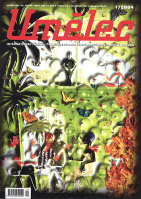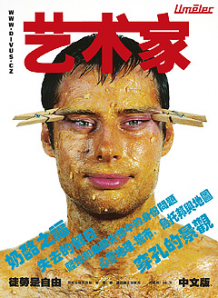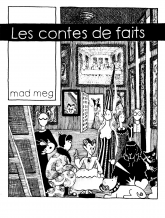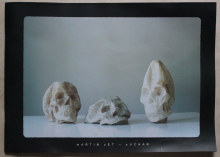| Umělec magazine 2004/1 >> Ján Mančuška: From Things to Their Meaning | List of all editions. | ||||||||||||
|
|||||||||||||
Ján Mančuška: From Things to Their MeaningUmělec magazine 2004/101.01.2004 Tomáš Pospiszyl | profile | en cs |
|||||||||||||
|
For several years now Ján Mančuška has been one of those rare species of artists — visible. This could be credited to his monumental installation projects, which in their variety and complexity demand of the viewer a great degree of awareness and an unusually long period of time to take them in. Consequently they remain seared in the minds of viewers somewhat longer than his four-second puns, which after all are entertaining but quickly drift out of the memory. His playfulness, visually rewarding (even ostentatious) installation forms and imaginative work with materials often interest viewers so much that they are satisfied to analyze the surface of his art and the real content often eludes them — content that radically differs from most installations made during the 1990s.
Mančuška’s first installations brought together everyday locations and familiar objects. They gave the impression that the artist had stripped them down to their individual components and then replaced the most essential elements with various materials or objects found close at hand. Grilled chicken was successfully imitated using badminton balls, skewers, adhesive tape, combs and wooden dowels; apartment interiors contained sinks carved from soap and sugar cube coffee cups. However surrealism, to this day a deep tradition in Czech art, is not at the base of this swapping of materials. His work does not exploit the poetic potential in combining the seemingly uncombinable — instead he is striving to ascertain and highlight the essence of individual objects. It could perhaps seem that Mančuška’s literally deconstructed installations fit into the world stream of model art, whose artists construct variously interpreted models of the surrounding world (Burden, Brower). Inspired by the gardens on Prague’s Libenský Island, Mančuška’s monumental work Kolonie (Colony) would especially fall within this trend. The individual structural and natural elements, shrunken down to the scale of an architectonic model, are once again made from unusual, discarded materials. Generally speaking, the goal of similar art models is to create an imaginary reality over which the artist has complete control, and which can be used in the telling of stories. These installations/models are made within the context of fine art, but thanks to their narrative potential they have much in common with film and literature. At first glance, even Kolonie could look like props perfect for making an animated film. However, soon one discovers that every external story is superfluous, and the simulated architecture itself says everything relevant. Kolonie is not the location of a story, but we could compare it to a kind of three-dimensional dictionary in which every cottage is described and interpreted using a slightly different language. They have in common only the monumentalization of small objects which, according to various identification keys, represent individual elements of the household and garden. Ján Mančuška’s ambition is not to take his art in the direction of storytelling. Rather than a writer-storyteller he is a linguist who is uninterested in spellbinding tales; he is really after the grammar which holds single words together and the different ways in which they are able to express their content. Within the story he is interested in how we are capable of perceiving it, and everything that is capable of expressing it. Everything that Ján Mančuška makes has the character of the perceptional conundrums or philosophical tools made, for example, by Joseph Kossuth. Mančuška does not separate out the individual levels and kinds of representation; on the contrary it is the overlap that fascinates him, the diffusion between the various possibilities of capturing reality and the schism of things existing in several dimensions and times at once. He also perceives the various tasks and functions that objects are able to fulfil and that characterize them no less than their visual appearance. Although Mančuška is not through with the three-dimensional object and installation, the artist has recently devoted himself to visual games, videos and artwork based on the written word. This comes from an artist who entered his career inconspicuously — in the beginning he experimented with graphic rhythms and geometric combinatorics. The regularly extending sequences of lines of light on the walls in the installation Čas, prostor, pohyb, příběh (Time, Space, Movement, Story) transformed into a spatial object that conformed to the same algorithms. Packaging of red pills fixed in a row gradually exhausted every possible sequence in which the patient can take them. Words made from long bent copper wires label all the floors of a tenement house from the entrance to the attic. Folded into a cardboard box, this object verges on being a conceptual sculpture and an absurd “novel in wire” which is reminiscent of the methods of the French “New Novel.” Mančuška does not try to block off an ambiguous interpretative path to the colorful range of the many different readings of reality, their interpretations and overlap. The work Cup demonstrates the richness of these possibilities. For this piece he wrote the word “cup” on the wall. As in the past when he opened objects up to their primary elements for a clearer understanding, here the word describing a simple object is a starting point for the dissection of anything that could be hidden inside this word. Cup shows that the object or the word are for Mančuška not the inner goals of his work, but the material used to analyze the world, proper substances for creating thought models that penetrate the world. The logical continuation of the conceptualization of Mančuška’s work is the complete abandonment of a visually interpreted depiction and the tendency towards pure text, as in his latest work called New Cinema Short Story. Storyboard Eva is primarily a literary figure and has nothing to do with visual art. In short paragraphs we watch as a scene repeats itself from the beginning again and again, but with every repetition it shifts in time slightly into the future. The repetition, and what at first sight seem to be unimportant shifts in the text, not only evoke a special atmosphere, but we discover that we — willingly or not — end up in a story that has, despite all its apparent perfunctory qualities, dramatic momentum. Mančuška’s dramatic character or playfulness is not simply unnecessary camouflage. Even children unconsciously learn while playing everything they will need in life, and Ján Mančuška is like a painter in a landscape who instead of traditional landscape painting creates mutually overlapping geographical, meteorological, demographic or simply subjective maps of the surrounding terrain. Whether the maps are beautiful or not is a accidental. The important thing is not only the information obtained from them but the knowledge of the complexity of the whole space, the richness of the various characteristics capable of describing it. The maps won’t help us to go from point A to point B, but thanks to them we begin to intuit the elevation points and contour lines in the surrounding world.
01.01.2004
Recommended articles
|
|||||||||||||
|
04.02.2020 10:17
Letošní 50. ročník Art Basel přilákal celkem 93 000 návštěvníků a sběratelů z 80 zemí světa. 290 prémiových galerií představilo umělecká díla od počátku 20. století až po současnost. Hlavní sektor přehlídky, tradičně v prvním patře výstavního prostoru, představil 232 předních galerií z celého světa nabízející umění nejvyšší kvality. Veletrh ukázal vzestupný trend prodeje prostřednictvím galerií jak soukromým sbírkám, tak i institucím. Kromě hlavního veletrhu stály za návštěvu i ty přidružené: Volta, Liste a Photo Basel, k tomu doprovodné programy a výstavy v místních institucích, které kvalitou daleko přesahují hranice města tj. Kunsthalle Basel, Kunstmuseum, Tinguely muzeum nebo Fondation Beyeler.
|

































 We Are Rising National Gallery For You! Go to Kyjov by Krásná Lípa no.37.
We Are Rising National Gallery For You! Go to Kyjov by Krásná Lípa no.37.
Comments
There are currently no comments.Add new comment